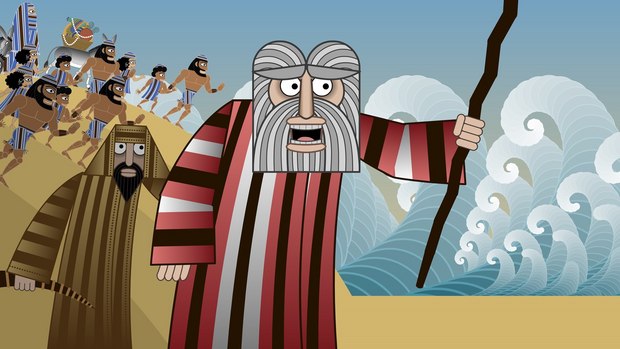Nina Paley’s extraordinary second feature is a biblical epic that you can dance to.
Having plumbed the depths of the Indian Ramayana in her 2008 feature Sita Sings the Blues, filmmaker Nina Paley sets her sights closer to home (cultural heritage-wise) in her new film Seder-Masochism. A wild ride through the traditional Passover Seder, this splendid 2D animation offers a cornucopia of rich graphics set to musical themes ranging from liturgical to pop, the whole as profoundly humorous and intellectually challenging as the best of Monty Python.
Knitting together the visuals is an informal dialogue between the filmmaker and her terminally ill, atheist Jewish father, who is still annoyed that Paley dropped out of university and isn’t earning a steady income. “He was just a frightened father worried about his kids,” says Paley. But in the biblical context of the film, it isn’t always clear exactly which patriarch Paley is referring to -- especially since Paley’s father is depicted here as a God-like figure arising from a U.S. dollar bill.
As an artist, Paley doesn’t shy from raising thorny issues and generating conflict. In Sita Sings the Blues, her irreverence opened her to charges of unwarranted cultural appropriation. While she felt strongly about the material and identified honestly with it, critics accused her of exploiting deeply meaningful elements from a culture with which she had no connection.
No such conflict is inherent in Seder Masochism, which began as a search for meaning in a ritual event familiar to Paley from her childhood. She was also attracted to these stories because, as part of the Old Testament, they are foundational to Christianity and Islam, as well as Judaism.
After working on the film for three years, Paley had much of the Exodus story animated, but found she could not identify strongly with any of the characters in the original text. She wanted to incorporate a strong feminine presence, so she searched the texts, the myths, the commentaries, and the commentaries on the commentaries. Where are the Jewish goddesses? In the biblical narrative, there is almost no mention of them.
At that point, she turned to other sources for inspiration, including The Creation of Patriarchy by Gerda Lerner and The Language of the Goddess by Marija Gimbutas. While these books were illuminating, Paley decided she wasn’t comfortable re-conceiving the film from a radical feminist position and chose to take a break, which wound up lasting several years.
Only very recently did the pieces fall into place. Seeking something spiritual and existential that she could relate to that was also supported by archeology, Paley conceived of an introductory sequence based on 30,000-year-old stone goddess carvings. Redrawing the carvings as vector images in the 2D animation software Moho, it dawned on her that Moho supports rasterized images. She taught herself how to animate the bitmaps, and once she got them dancing, the pieces of the narrative began to come together.
Perhaps not surprisingly, the most endearing characters in the film are not the patriarchs, but these dancing goddesses. Animating them to the gospel standard “(Give Me) That Old Time Religion,” Paley has them bopping in and out of the story, giving her revisionist narrative an overall structure, as well as a delicious twist.
Paley brings in another goddess element by re-imagining the idol-making at the foot of Mount Sinai. Instead of a calf, the molten gold takes the form of the ancient Egyptian deity Hathor, a fertile woman with the head of a cow. Was it she whom the Israelites were dreaming of while Moses climbed Mount Sinai in search of laws and rules? It’s an interesting and provocative thesis, an invitation to debate, which of course is what the Seder is all about.
As if all of this were not enough food for thought, Paley also challenges us on the issue of terrorism, finding a parallel between twenty-first century extremists destroying priceless artifacts and the smashing of idols, as dictated in Exodus. To add to the cognitive dissonance, Paley sets this scene to the 70s pop hit “The Things We Do For Love” by the band 10cc.
The film’s most affecting narrative through line comes from the recorded conversations Paley has with her gravely ill father. In these sequences, Paley visualizes herself as a small goat -- a loaded image, considering the many references to the sacrificing of goats in the Bible. Her father, in his dollar bill skin and long flowing beard and mane, presides in fatherly fashion over a family Seder table. Cultural rather than religious Jews, her extended family used the Seder to tell the exodus story and argue about which rituals were morally proper to follow and which should be omitted in the name of compassion. The father-daughter conversation, and bits of family history that Paley interpolates, imbue the film with a poignant personal component that grounds the more outrageous and whimsical elements.
Visually, the film offers a profusion of delights, with every scene providing its own pleasures. Among these are the marvelous use of light and dark as characters move from brightness and life to shadow and death; Escher-like negative-positive space reversals and illusions; and the remarkable dancing Venus of Willendorf figurines, which appear only briefly, but are a joy to watch. Also, if you are not too busy tapping your toes or snapping your fingers to Louis Armstrong’s rendition of “Go Down Moses,” you might notice that the bouncing ball in some of the shots is actually tracking vowels and consonants on the wall of hieroglyphs behind the central characters, spelling out the English words phonetically.
Coming in at just over an hour, Seder-Masochism is so full of visual, intellectual and emotional stimulation that it seems much shorter. In its own way, it’s something of a Passover miracle.
This article originally appeared in the Special Annecy 2018 Edition of ANIMATIONWorld Magazine.





















